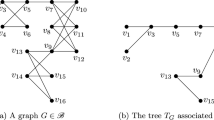Abstract
We previously proposed the first nontrivial examples of a code having support t-designs for all weights obtained from the Assmus–Mattson theorem and having support \(t'\)-designs for some weights with some \(t'>t\). This suggests the possibility of generalizing the Assmus–Mattson theorem, which is very important in design and coding theory. In the present paper, we generalize this example as a strengthening of the Assmus–Mattson theorem along this direction. As a corollary, we provide a new characterization of the extended Golay code \({\mathcal {G}}_{24}\).
Similar content being viewed by others
References
Alltop W.O.: Extending \(t\)-designs. J. Comb. Theory Ser. A 18, 177–186 (1975).
Assmus E.F. Jr., Mattson H.F. Jr.: New \(5\)-designs. J. Comb. Theory 6, 122–151 (1969).
Bachoc C.: On harmonic weight enumerators of binary codes. Des. Codes Cryptogr. 18(1–3), 11–28 (1999).
Bannai E., Koike M., Shinohara M., Tagami M.: Spherical designs attached to extremal lattices and the modulo p property of Fourier coefficients of extremal modular forms. Mosc. Math. J. 6, 225–264 (2006).
Bannai E., Miezaki T.: Toy models for D. H. Lehmer’s conjecture. J. Math. Soc. Jpn. 62(3), 687–705 (2010).
Bannai E., Miezaki T.: Toy models for D. H. Lehmer’s conjecture II. In: Quadratic and Higher Degree Forms, pp. 1–27. Springer, New York (2013).
Bannai E., Miezaki T., Nakasora H.: A note on the Assmus–Mattson theorem for some binary codes II, in preparation.
Bannai E., Miezaki T., Yudin V.A.: An elementary approach to toy models for Lehmer’s conjecture. (Russian) Izv. Ross. Akad. Nauk Ser. Mat. 75(6), 3–16 (2011); translation in Izv. Math. 75(6), 1093–1106 (2011).
Betsumiya K., Munemasa A.: On triply even binary codes. J. Lond. Math. Soc. 86(1), 1–16 (2012).
Cameron P.J., van Lint J.H.: Designs, Graphs, Codes and Their Links, London Mathematical Society Student Texts, vol. 22. Cambridge University Press, Cambridge (1991).
Delsarte P.: Hahn polynomials, discret harmonics, and \(t\)-designs. SIAM J. Appl. Math. 34(1), 157–166 (1978).
Höhn G.: Conformal designs based on vertex operator algebras. Adv. Math. 217–5, 2301–2335 (2008).
Horiguchi N., Miezaki T., Nakasora H.: On the support designs of extremal binary doubly even self-dual codes. Des. Codes Cryptogr. 72, 529–537 (2014).
Lehmer D.H.: The vanishing of Ramanujan’s \(\tau (n)\). Duke Math. J. 14, 429–433 (1947).
Macwilliams J.: A theorem on the distribution of weights in a systematic code. Bell Syst. Tech. J. 42, 79–84 (1963).
Miezaki T.: Conformal designs and D.H. Lehmer’s conjecture. J. Algebra 374, 59–65 (2013).
Miezaki T.: Design-theoretic analogies between codes, lattices, and vertex operator algebras. Des. Codes Cryptogr. 89(5), 763–780 (2021).
Miezaki T., Munemasa A., Nakasora H.: An note on Assmus-Mattson theorems. Des. Codes Cryptogr. 89, 843–858 (2021).
Miezaki T., Nakasora H.: An upper bound of the value of \(t\) of the support \(t\)-designs of extremal binary doubly even self-dual codes. Des. Codes Cryptogr. 79, 37–46 (2016).
Miezaki T., Nakasora H.: The support designs of the triply even binary codes of length \(48\). J. Comb. Des. 27, 673–681 (2019).
Venkov B.B.: Even unimodular extremal lattices (Russian), Algebraic geometry and its applications. Trudy Mat. Inst. Steklov. 165, 43–48 (1984); translation in Proc. Steklov Inst. Math. 165, 47–52 (1985).
Venkov B.B.: Réseaux et designs sphériques, (French) [Lattices and spherical designs] Réseaux euclidiens, designs sphériques et formes modulaires, 10–86, Monogr. Enseign. Math., 37, Enseignement Math., Geneva (2001).
Wolfram Research, Inc., Mathematica, Version 11.2, Champaign (2017).
Acknowledgements
The authors thank Akihiro Munemasa for helpful discussions and computations in this research. Hiroyuki Nakasora thanks Masaaki Harada and Hiroki Shimakura for their comments in a seminar at Tohoku university. Tsuyoshi Miezaki is supported by JSPS KAKENHI (18K03217).
Author information
Authors and Affiliations
Corresponding author
Additional information
Communicated by V. D. Tonchev.
Publisher's Note
Springer Nature remains neutral with regard to jurisdictional claims in published maps and institutional affiliations.
Appendices
Appendix A Values of \(X_{ij}\)
Appendix B
See Table 1.
Rights and permissions
About this article
Cite this article
Miezaki, T., Nakasora, H. A note on the Assmus–Mattson theorem for some binary codes. Des. Codes Cryptogr. 90, 1485–1502 (2022). https://doi.org/10.1007/s10623-022-01050-2
Received:
Revised:
Accepted:
Published:
Issue Date:
DOI: https://doi.org/10.1007/s10623-022-01050-2




